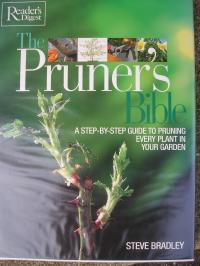Book Review - The Pruner's Bible

A very useful book to refer to before pruning any plants in your garden.
4 Stars
Author: Steve Bradley
Publisher: The Reader's Digest Association Ltd & Quarto Publishing plc
Published: 2005
ISBN: 0-276-42945-1
Every gardener should arm themselves with a decent reference book about pruning. Many gardeners find the whole subject of pruning confusing and pruning a plant correctly is often left to chance. Someone once said to me that "When it comes to pruning you are either a butcher or a hairdresser". I think it is a bit more skilled than that and The Pruner's Bible will help you to improve your pruning knowledge and skills.
The Pruner's Bible begins with a How to use this book section. The main body of the book is dedicated to a Plant Directory of more than 70 of the most commonly grown garden plants that you are likely to want to prune. The How to use this book section gives pictorial examples of how the Plant Directory is laid out.
A comprehensive introductory chapter to the subject of pruning then follows entitled Pruning Essentials. It is broken down into sub-sections explaining the main principles and issues surrounding pruning. For example, there are sections on Tools and Equipment, Health and Safety and Basic Techniques.
The main bulk of the book now follows, being the Plant Directory. Each plant Genus has at least 2 pages of information dedicated to it. Some Genera that are notoriously "difficult" to prune amongst the gardening fraternity have larger sections. Clematis and Wisteria for example have 6 and 4 pages dedicated to them respectively. The subject of rose pruning is dealt with by splitting Roses into five clear groups over 10 pages, with excellent, detailed information given on the pruning requirements of the plants within each group.
Using the Genus Callicarpa as an example each Plant Directory provides the following information:
- Any common names for the Genus e.g. Beautyberry
- The attributes of the Genus: e.g. "Callicarpas are grown for there small, round brightly coloured fruits which are borne in generous clusters after a long, hot summer and last well into the winter".
A more detailed description of Callicarpa then follows discussing hardiness, growth habit, soil and site requirements and details of the flowers, leaves and fruits.
- A large colour photograph of the plant
- A large drawing showing where pruning cuts should be made
- Concise, mini sections entitled Why Prune?, Pruning Tips, Plants pruned this way, which summarises the different species and cultivars and at which time of year each one needs pruning. Which Tools? has mini photos of the best tools to use.
Within the Plant Directory the possible pruning techniques for each Genus are split into 3 sections entitled Formative Pruning, Routine Pruning, and Remedial Pruning.
These 3 parts provide a comprehensive guide to all the pruning required, from very young or newly purchased plants to periodical, routine pruning of mature, healthy examples and finally recovery pruning for older plants that might have been neglected over a number of years.
Most of the Plant Directory is understandably dedicated to shrubs and climbers. These are the most likely plant types that are gardener; amateur or professional, is likely to seek advice about. However, a Special Features section towards the end of the book, following the Plant Directory looks, more generally at the pruning of trees, conifers, hedges, climbers and low growing groundcover plants. Most gardeners need no more information about the pruning of these plant groups. Trees, for example after a few years usually grow so big that pruning can only be done by a professional tree surgeon. Hedges and conifers generally need minimal pruning; less thought provoking trimming and shaping is more likely. There is also a section on Specialised Pruning providing an insight into techniques like pollarding and coppicing.
As you would expect of a reference book of this quality, there is a useful glossary at the end of the book if you are unsure about any of the technical or scientific terms used.
How can the book be improved?
Well, my only criticism of The Pruner's Bible is that there is not a special section in the book dedicated to the pruning of fruit trees and bushes. I have come across many a gardener who would like to know how and when to prune apple trees correctly or how get a larger crop from a gooseberry bush.
Gardening Guru's Verdict
The Pruner's bible will undoubtedly add to any gardener's knowledge and interest in pruning. If you are at all unsure about how to prune any of the plants in your garden this book will help you. The Pruner's Bible will teach you how to prune plants properly and if you follow the advice given you may well end up with a healthier, more floriferous garden.
This book was reviewed by George Munford.

